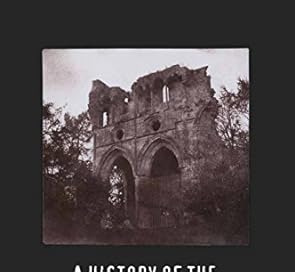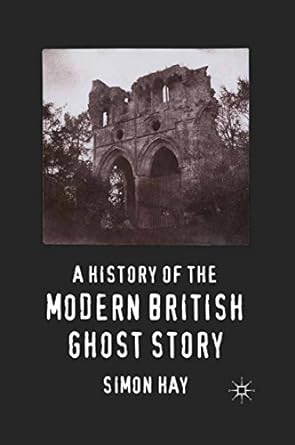A History of the Modern British Ghost Story (2011) by Simon Hay
Page 18:
Nineteenth century British social reality – that is to say, the network of relationships, interdependencies, flows of bodies, trade goods, money, ideas and information, the social totality that structures the world of the ghost stories, the truth underlying the mere experiences of the lives of characters and readers – this social reality has included from the genre’s beginnings absolutely the hard facts of empire. The social relationships that the ghost story addresses, as it tries to imagine solutions for the social crises these relations increasingly find themselves confronting throughout modernity, are insistently imperial ones.
19:
they function as narrative examples of one of Adorno’s aphorisms: ‘The expression of history in things is no other than that of past torment’ (1974, p. 49). In ghost stories, the key figure for the history-as-suffering is precisely the haunted house: houses are loci of a history of suffering and trauma, instantiated in the persistence of such feudal property as aristocratic mansions, manors, castles and abbeys.
20:
illustrates one of these ways that the ghost story asks us to think about history. The story’s narrator, an American on tour in Europe, remarks on the sense of history visible to him in the very landscape and especially in the property that he observes, instantiating a stereotypically American attitude to Europe: Europe is characterized not so much by the possession of history, insofar as ‘history’ then means ‘traditions of aristocratic possession,’ a possession that America by comparison lacks, but rather by the idea of history as the transition from such a feudal-aristocratic state to a modern one. (Such a characterization in turn implies that only white people ‘have’ history, or only white history matters, a claim even more visible in ghost stories with imperial settings.) In the logic of the ghost story, history resides in architecture and landscape; time and memory take on physical embodiment
21:
“puffing my cigarette smoke into the face of such a past”
26:
At the level of form, then, genre is the presence of the past in the present’; ‘genres not only emerge from specific historical situations but carry that ideology in themselves as a ghostly aftereffect, even when the circumstances have changed’
26:
The genre whose project most explicitly addresses problems of spectrality, of the visible and the invisible, of the way that the not-present haunts the present (whether that is meant spatially or temporally), is realism, understood in the broadest Lukácsian sense, that is to say, narratives concerned with the representation of the social and structural totality that underlies, invisibly, the experiences of the everyday. And it is in relation to the various modes of realism that this book explains the work of the ghost story.
27:
The realist novel sets out to provide its readers with these structural coordinates; or, in spectral terms, to make visible what is invisible to ordinary experience – with the important proviso that the novel was always better at doing this for a single city or single nation than for the empire as a whole.
27:
Haunted characters usually experience ghosts as horrifying, and their terror enacts the sudden visibility of the structures normally invisible beneath the surface. Sometimes the sociological function of the ghost (as structural truth) is foregrounded, as in Sheridan Le Fanu’s ‘The Watcher,’ in which the protagonist explains that this spiritual world is ‘a system whose workings are generally in mercy hidden from us – a system which may be, and which is sometimes, partially and terribly revealed’ (28). But more often, this structural role is implicit, as in ‘The Open Door,’ where the social factors that underlie the lived experience of the characters – the role of empire, of merchant capital behind and beneath but also comingled with the landed gentry, but also history itself – are all figured in the ghost story through the process of haunting.
28:
Science fiction and detective stories progress toward clarity, transparency, and explicit illumination of a puzzle or concept. They depend on the power of reason and logic; they invariably explain themselves. Ghost stories, however, sabotage the relationship between cause and effect. The parts are self-consistent, but they relate to an inexplicable, irrational whole. (Sullivan 1978, p. 134) This is right in insisting that we understand ghost stories as relating to (and relating to us) a ‘whole’ picture of their and our social world, and even in understanding that totality as irrational, but wrong in suggesting that ghost stories refuse to explain or illuminate
28:
Any given story can be explained in primarily formalist terms: some of the key ones in the chapters that follow are tropes and figures, the construction and role of the narrator, the shape and function of introductory frames, and the completeness of the narrative.
29:
Realist novels (understood most broadly, again, as including the historical novel, Dickensian realism, naturalism, even modernism in a certain sense) and ghost stories alike are engaged in a project of teaching us how to think about, giving us a language and a cognitive framework for understanding, the social forces that make up our everyday reality. In certain circumstances, at certain moments, the ghost story performs this function better than the realist novel; at other moments, it functions as a critique of the realist project.
29:
Focusing on the ghost story as the underside of or the alternative history of the novel makes visible a series of ideas about the novel, ideas otherwise invisible.
30
“Gothic theory” ….means two quite different things. There is, first of all, the theory of the gothic, theorizations of gothic literature and culture, with which this book largely avoids any direct engagement. The ghost story is in all sorts of ways a sub-genre of the gothic; in some ways, such as its central concern with both the trauma of the transition from feudalism to capitalism and with the repetition of that trauma through processes of imperialism, the ghost story is a paradigmatic gothic narrative
30:
second, ‘gothic theory’ means not the theory of the gothic but the gothic in theory.
30:
we need to read ghosts politically, that is, to pay attention to the specific meanings and contexts of any particular ghost: ‘surely we have to risk the violence of reading the ghost, of cracking open its absent presence to answer the demand of its specific symptomatology and its specific locale
32:
naturalism did happen in Britain; however, not in the genre of the novel, but rather in the counterintuitive genre of the ghost story. And this naturalist supernatural became the dominant mode of ghost story writing over the late nineteenth and early twentieth centuries, the period generally considered the ‘golden age’ of the ghost story. M. R. James’s ghost stories are exemplary here, in foregrounding their naturalism but also in terms of Horkheimer and Adorno’s argument that the perfection of a style marks that style’s failure, its capitulation to the existing order. The perfection of the ghost story in its ‘golden age’ naturalist form, that is, is also the foreclosure of the genre’s possibility of critique.
32:
there are a large number of naturalist ghost stories that take as their setting the hinterlands of the British Empire.
33:
imperial violence makes empire a thing of horror; Conrad’s Heart of Darkness is the most famous narrative showing the dependence of each on the other, but it is the project of imperial ghost stories, too, to strap the two together. In these explicitly imperialist ghost stories, the colony and its people are horrors; but so too is empire.
33:
Walter Benjamin’s claim that ‘The world dominated by its phantasmagorias – this . . . is “modernity”’
33:
Modernity is characterized by ghostliness, a ghostliness that consists not of the past’s persistence into the present but rather of the insubstantiality of the modern itself: of the market, the city, technology, the bourgeois home, and relationships premised on these institutions.
34:
Not every ghost story features a pair of binoculars made from the distilled essence of the dead that allow one to literally see the past, as does M. R. James’s ‘A View from a Hill,’ but that story literalizes what is structural about ghost stories as a whole, their focus as a genre on the relationship between the present and its history, and in particular traumatic history, and on how we relate to the dead.
34:
Offering models for how we relate to the dead is then one of the central projects of the ghost story.
34:
Radical historians are not interested in articulating the past ‘the way it really was,’ but rather in making use of the past ‘as it flashes up in a moment of danger.’
34:
‘even the dead will not be safe’ A Failed Modernity: The Ghost Story as the Bad Conscience of the Historical Novel
36:
What is the [historical novel] indeed, if not an attempt to raise the dead, to stage a hallucinatory fantasmagoria in which the ghosts of a vanished past once again meet in a costumed revel, surprised by the mortal eye of the contemporary spectator-voyeur?
36:
the historical novel and the ghost story both stage history for us by bringing the dead before us as a spectacle.
49:
Waverley becomes an uncomplicated modernity narrative. History is turned into a spectacle, and the reader functions as a spectator who benefits, who garners the pleasures of sympathy and spectatorship without accruing non-monetary responsibility or importunate neighbors. Scott’s ghost stories, as we saw with ‘The Highland Widow’ and as we shall see with ‘The Tapestried Chamber,’ insist on the limitations of such a spectatorial position, and insist on what gets left out of such narratives. It is in this sense that ghost stories are more insistently historical than the novel-form that bears that name.
Jay
9 December 2023





Looks like an interesting book 👍
That sounds great!